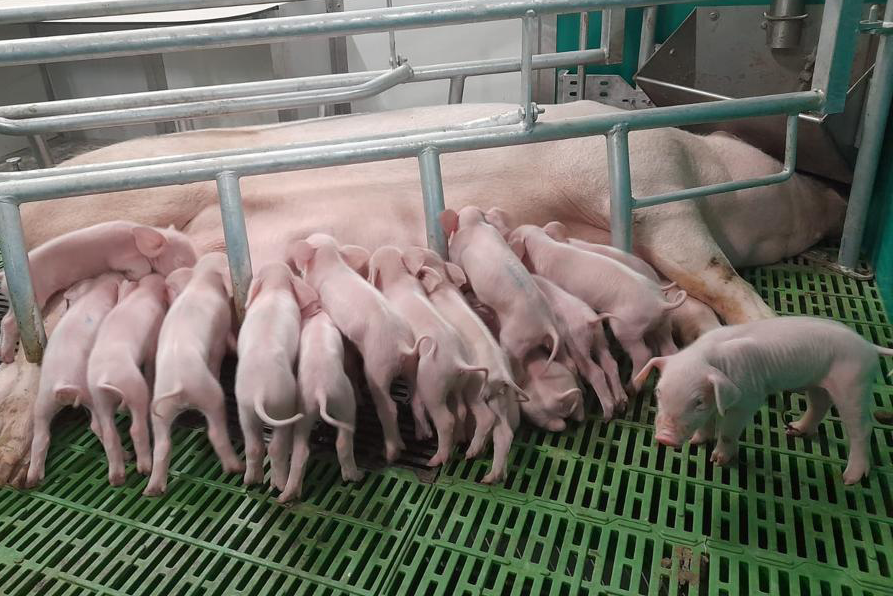When it comes to efficiency in finishing, every experienced pig farmer and especially the finishing farmers think of a Duroc as the sire. This is because the Danish Duroc in particular is seen as synonymous with fast growth and good feed conversion. What can still be improved in this terminal boar type? Will other criteria become important in the future? Or other criteria?
Efficiency continues to play an important role
First and foremost, finishing farmers rely on a Duroc to achieve higher gains and thus more turnovers, i.e. better barn space utilization. At the same time, feed efficiency remains important, because even if feed prices are currently falling, feed is and will remain the biggest cost factor in pig production. And let’s not forget the material balance … What has gone into production somehow also comes out again, preferably as meat, of course, but slurry cannot be avoided.
Focus on sustainability and animal welfare
With the well-known good efficiency of Duroc fattening piglets, farmers also contribute to more sustainability in pig production at the same time. And through their vitality and robustness, they also contribute to greater animal welfare.
Is that all? No!
There is (even) more or better to be done. Since 2018, PIC has had a Duroc line of Danish origin in its portfolio, the PIC®800, and is improving it through breeding. In doing so, the main attributes of a successful Duroc are always the basis so that you can already rely on your fattening piglets being superior in terms of growth and feed efficiency now and in the future.

More data and more meaningful data
Numbers, data, facts are always the basis for successful breeding work. The more practice-oriented the information is collected, the more comprehensive the database is, the better performance data and genetic information are linked, the more effective it is for breeding work.
- Every year, about 100,000 animals are added to the database as part of PIC’s practical testing programme. That is about 3 million records.
- The pedigree is recorded for all these animals.
- Testing takes place in practice farms with average health levels.
- All PIC boars are genotyped before the performance test so that all relationship data and all practice data are correctly linked and thus the accuracy of the index is already significantly higher at selection than in other breeding programmes.
- A detailed feet and leg evaluation is carried out for each breeding animal, differentiated in front and back leg position. With the introduction of camera-based recording last autumn, this evaluation will be further optimised and objectified. READ MORE about the use of artificial intelligence in pig breeding.
The use of data from practical farms is therefore so important, so that very good performance can also be achieved under ‘normal’ practical conditions – and not only in the highly healthy nucleus farm with all the possibilities of care. Especially when it comes to robustness, selection based on data from the right environment delivers the fastest breeding progress.
And it works …
Both subjectively and objectively, the feedback from practice proves that e.g. the more differentiated and detailed leg and feet evaluation is successful.
“We can see a clearly positive development in legs and feet,” confirm several managers at partner GTCs. This rather subjective assessment is confirmed by the numbers of complaints due to legs and feet, which have been continuously decreasing since 2018.
Additional differentiation through rapid progress in other traits
Did you know that PIC has been selecting directly for the trait “meat tenderness” in all boar lines since 2018?
Technically, the perception of “meat tenderness” is nothing more than the strength of the resistance with which the piece of meat has to be chewed. Resistance – even of meat – can be measured. For all carcasses that are dissected in detail as part of PIC’s data collection of commercial slaughter pigs, this is measured with the so-called Warner-Bratzler scissors.
This procedure, together with the well-known method of measuring intramuscular fat, which is generally used as a criterion for meat quality, ensures that you can produce meat with the PIC®800 that does not have to hide behind the quality of, for example, Berkshire, which is also often compared with meat from Wagyu cattle.


In the same year as the direct selection for meat quality, in addition to back fat and muscle thickness, the cuts were also included in the index as individual traits.
Conclusion: It is time for more Duroc …
To come back to the question posed at the beginning ” Duroc – is there even more possible?” the answer can only be: “Absolutely! Proven efficiency can be complemented with new features to increase the differentiation advantage.”
CONTACT your PIC representative to learn more about the PIC®800.




